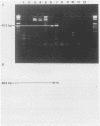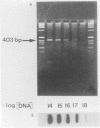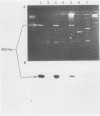Abstract
A polymerase chain reaction (PCR)-based assay was developed for the detection of Pneumocystis carinii DNA in induced sputum and bronchoscopic alveolar lavage samples. The primer pair was selected from the published sequence of the thymidylate synthase gene of P. carinii derived from infected rats. The amplified DNA fragment of 403 bp was detected by agarose gel electrophoresis and by Southern and slot blot hybridization. No positive reaction was seen with DNA from different microorganisms typically found in the respiratory tract. P. carinii DNA was demonstrated in 30 of 42 sputum samples from immunosuppressed patients, whereas 21 of 42 sputum samples were positive by indirect immunofluorescence (IFL). Among the 42 patients, 14 were receiving prophylactic chemotherapy. In that group, PCR detected P. carinii in nine sputum samples, whereas IFL detected P. carinii in only four sputum samples. A positive PCR result was also seen in 5 of 43 IFL-negative bronchoscopic alveolar lavage samples from patients with respiratory symptoms. The PCR assay detected 10 copies of the target DNA, which corresponds to 10(-18) g of the specific P. carinii sequence. The results indicate that PCR amplification in combination with DNA hybridization is specific and is a more sensitive diagnostic method than IFL for the detection of P. carinii.
Full text
PDF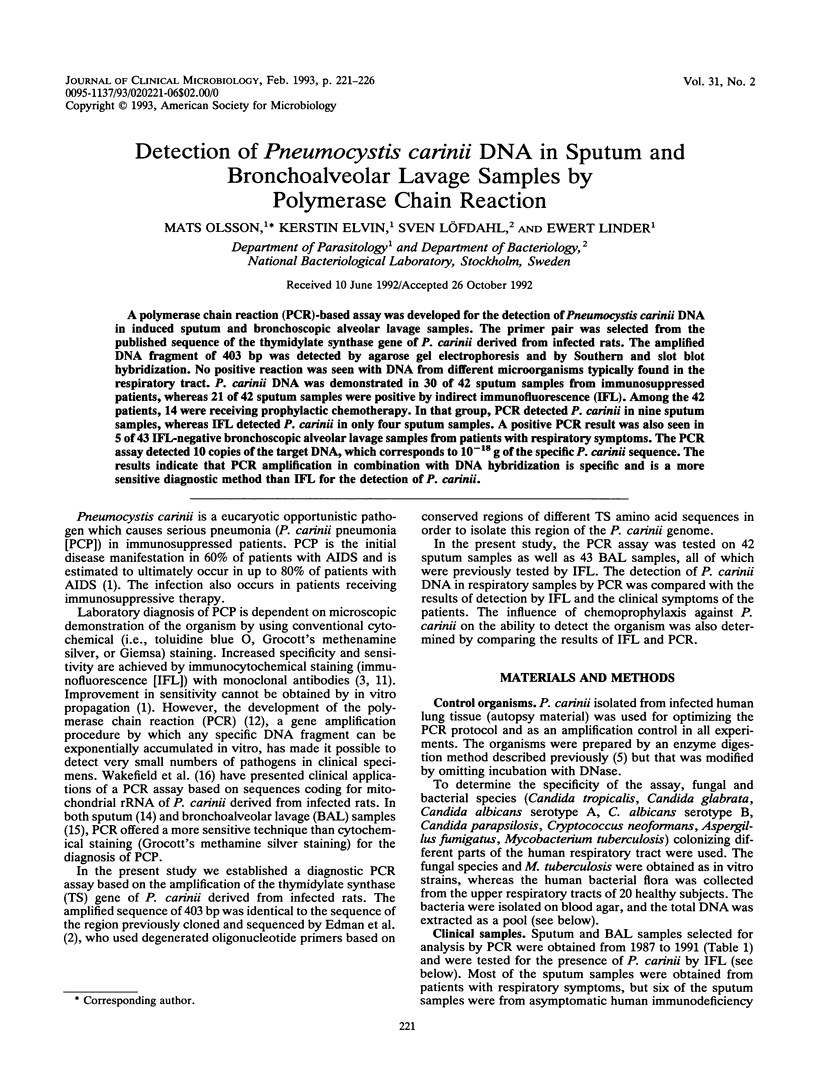

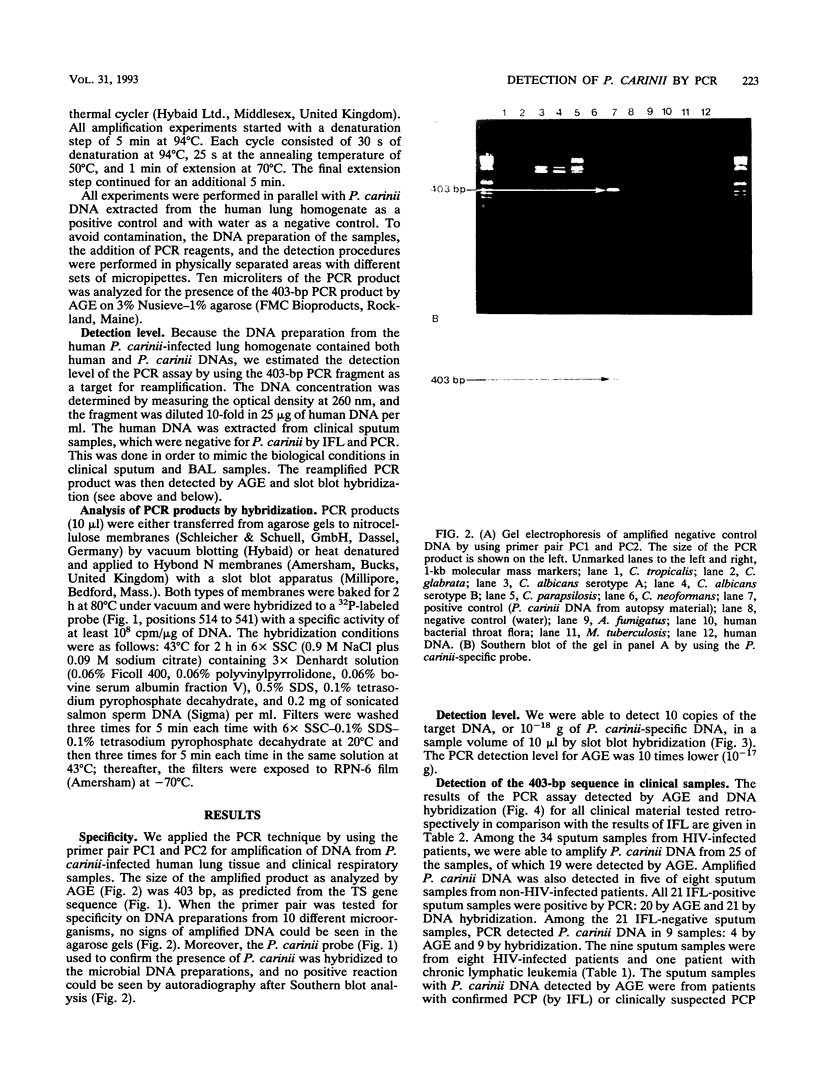
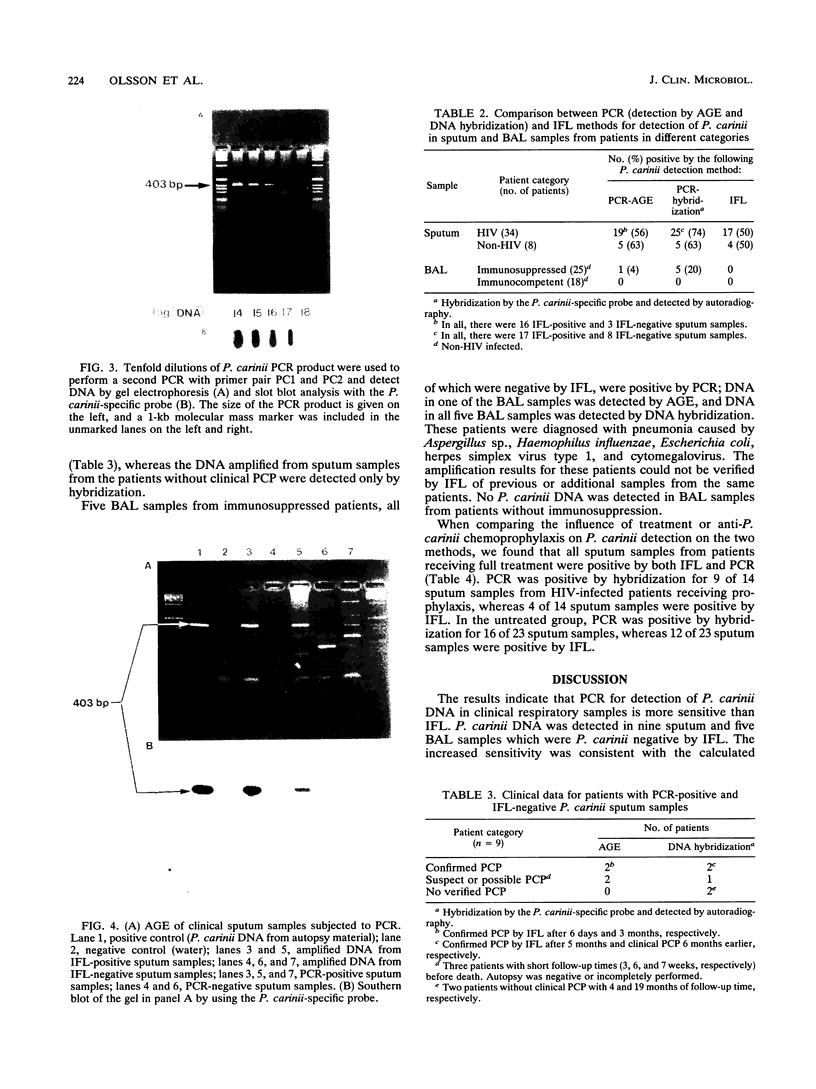
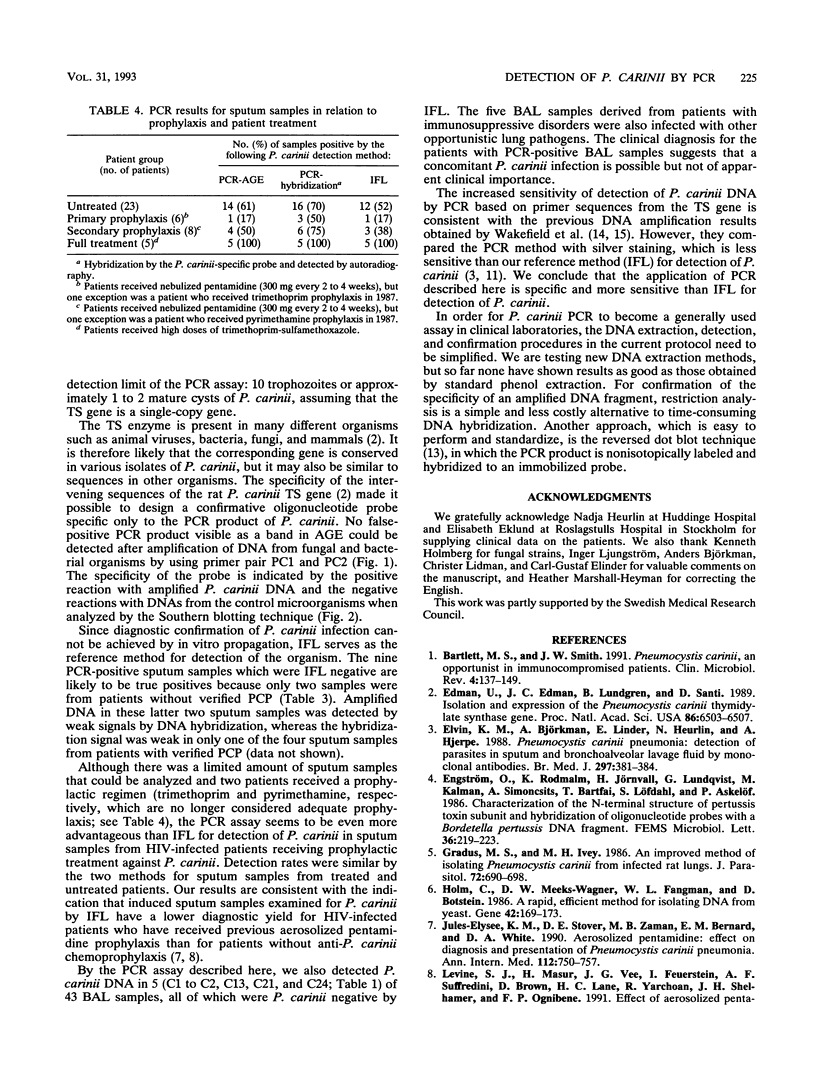

Images in this article
Selected References
These references are in PubMed. This may not be the complete list of references from this article.
- Bartlett M. S., Smith J. W. Pneumocystis carinii, an opportunist in immunocompromised patients. Clin Microbiol Rev. 1991 Apr;4(2):137–149. doi: 10.1128/cmr.4.2.137. [DOI] [PMC free article] [PubMed] [Google Scholar]
- Edman U., Edman J. C., Lundgren B., Santi D. V. Isolation and expression of the Pneumocystis carinii thymidylate synthase gene. Proc Natl Acad Sci U S A. 1989 Sep;86(17):6503–6507. doi: 10.1073/pnas.86.17.6503. [DOI] [PMC free article] [PubMed] [Google Scholar]
- Elvin K. M., Björkman A., Linder E., Heurlin N., Hjerpe A. Pneumocystis carinii pneumonia: detection of parasites in sputum and bronchoalveolar lavage fluid by monoclonal antibodies. BMJ. 1988 Aug 6;297(6645):381–384. doi: 10.1136/bmj.297.6645.381. [DOI] [PMC free article] [PubMed] [Google Scholar]
- Gradus M. S., Ivey M. H. An improved method of isolating Pneumocystis carinii from infected rat lungs. J Parasitol. 1986 Oct;72(5):690–698. [PubMed] [Google Scholar]
- Holm C., Meeks-Wagner D. W., Fangman W. L., Botstein D. A rapid, efficient method for isolating DNA from yeast. Gene. 1986;42(2):169–173. doi: 10.1016/0378-1119(86)90293-3. [DOI] [PubMed] [Google Scholar]
- Jules-Elysee K. M., Stover D. E., Zaman M. B., Bernard E. M., White D. A. Aerosolized pentamidine: effect on diagnosis and presentation of Pneumocystis carinii pneumonia. Ann Intern Med. 1990 May 15;112(10):750–757. doi: 10.7326/0003-4819-112-10-750. [DOI] [PubMed] [Google Scholar]
- Linder E., Lundin L., Vorma H. Detection of Pneumocystis carinii in lung-derived samples using monoclonal antibodies to an 82 kDa parasite component. J Immunol Methods. 1987 Apr 2;98(1):57–62. doi: 10.1016/0022-1759(87)90435-2. [DOI] [PubMed] [Google Scholar]
- Ng V. L., Yajko D. M., McPhaul L. W., Gartner I., Byford B., Goodman C. D., Nassos P. S., Sanders C. A., Howes E. L., Leoung G. Evaluation of an indirect fluorescent-antibody stain for detection of Pneumocystis carinii in respiratory specimens. J Clin Microbiol. 1990 May;28(5):975–979. doi: 10.1128/jcm.28.5.975-979.1990. [DOI] [PMC free article] [PubMed] [Google Scholar]
- Saiki R. K., Gelfand D. H., Stoffel S., Scharf S. J., Higuchi R., Horn G. T., Mullis K. B., Erlich H. A. Primer-directed enzymatic amplification of DNA with a thermostable DNA polymerase. Science. 1988 Jan 29;239(4839):487–491. doi: 10.1126/science.2448875. [DOI] [PubMed] [Google Scholar]
- Saiki R. K., Walsh P. S., Levenson C. H., Erlich H. A. Genetic analysis of amplified DNA with immobilized sequence-specific oligonucleotide probes. Proc Natl Acad Sci U S A. 1989 Aug;86(16):6230–6234. doi: 10.1073/pnas.86.16.6230. [DOI] [PMC free article] [PubMed] [Google Scholar]
- Wakefield A. E., Guiver L., Miller R. F., Hopkin J. M. DNA amplification on induced sputum samples for diagnosis of Pneumocystis carinii pneumonia. Lancet. 1991 Jun 8;337(8754):1378–1379. doi: 10.1016/0140-6736(91)93062-e. [DOI] [PubMed] [Google Scholar]
- Wakefield A. E., Pixley F. J., Banerji S., Sinclair K., Miller R. F., Moxon E. R., Hopkin J. M. Amplification of mitochondrial ribosomal RNA sequences from Pneumocystis carinii DNA of rat and human origin. Mol Biochem Parasitol. 1990 Nov;43(1):69–76. doi: 10.1016/0166-6851(90)90131-5. [DOI] [PubMed] [Google Scholar]
- Wakefield A. E., Pixley F. J., Banerji S., Sinclair K., Miller R. F., Moxon E. R., Hopkin J. M. Detection of Pneumocystis carinii with DNA amplification. Lancet. 1990 Aug 25;336(8713):451–453. doi: 10.1016/0140-6736(90)92008-6. [DOI] [PubMed] [Google Scholar]



